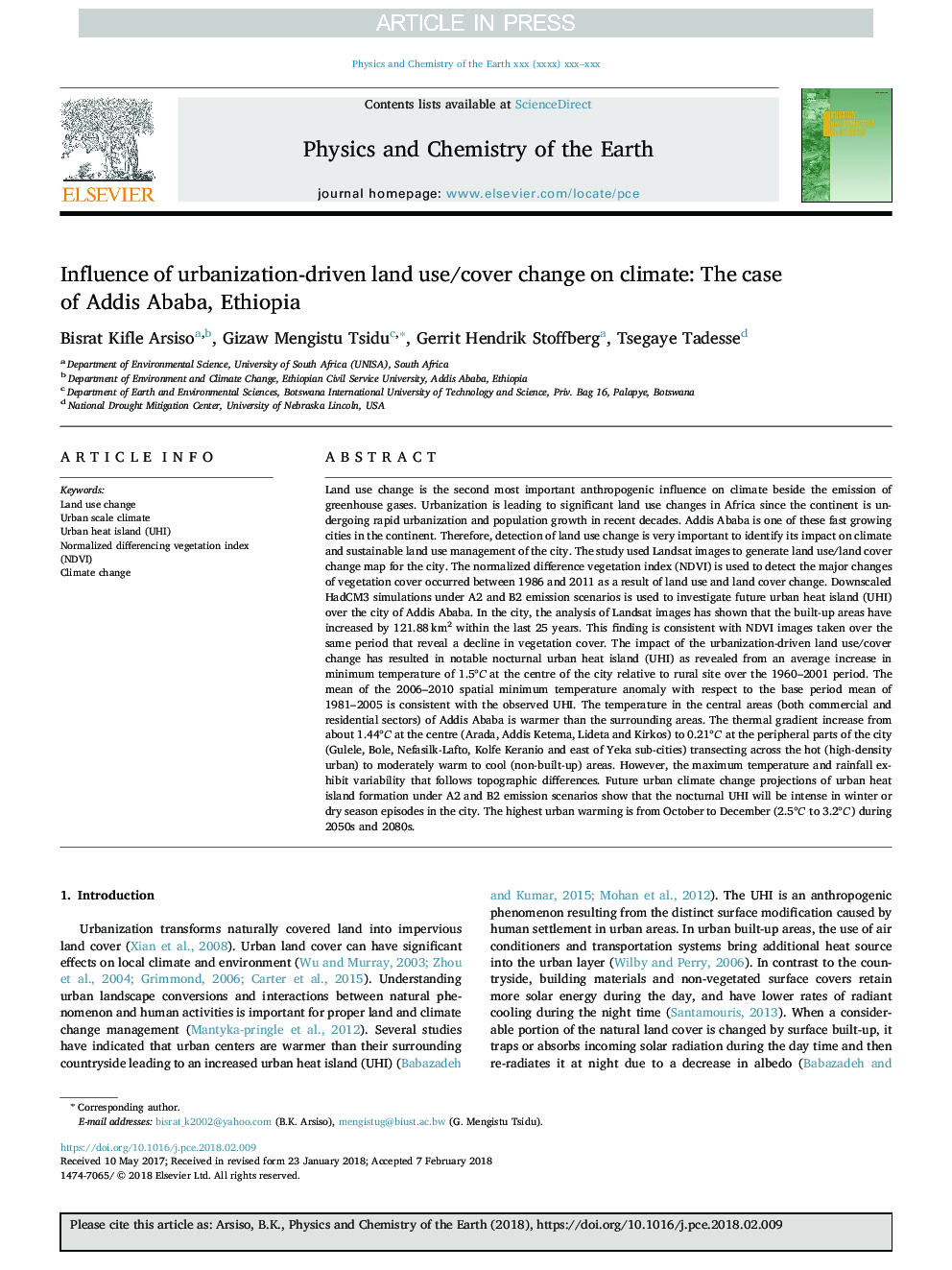| کد مقاله | کد نشریه | سال انتشار | مقاله انگلیسی | نسخه تمام متن |
|---|---|---|---|---|
| 8912362 | 1639333 | 2018 | 12 صفحه PDF | دانلود رایگان |
عنوان انگلیسی مقاله ISI
Influence of urbanization-driven land use/cover change on climate: The case of Addis Ababa, Ethiopia
ترجمه فارسی عنوان
تأثیر تغییر کاربری زمین / تغییر پوشش در آب و هوای شهری: مورد آدیس آبابا، اتیوپی
دانلود مقاله + سفارش ترجمه
دانلود مقاله ISI انگلیسی
رایگان برای ایرانیان
کلمات کلیدی
موضوعات مرتبط
مهندسی و علوم پایه
علوم زمین و سیارات
ژئوشیمی و پترولوژی
چکیده انگلیسی
Land use change is the second most important anthropogenic influence on climate beside the emission of greenhouse gases. Urbanization is leading to significant land use changes in Africa since the continent is undergoing rapid urbanization and population growth in recent decades. Addis Ababa is one of these fast growing cities in the continent. Therefore, detection of land use change is very important to identify its impact on climate and sustainable land use management of the city. The study used Landsat images to generate land use/land cover change map for the city. The normalized difference vegetation index (NDVI) is used to detect the major changes of vegetation cover occurred between 1986 and 2011 as a result of land use and land cover change. Downscaled HadCM3 simulations under A2 and B2 emission scenarios is used to investigate future urban heat island (UHI) over the city of Addis Ababa. In the city, the analysis of Landsat images has shown that the built-up areas have increased by 121.88â¯km2 within the last 25 years. This finding is consistent with NDVI images taken over the same period that reveal a decline in vegetation cover. The impact of the urbanization-driven land use/cover change has resulted in notable nocturnal urban heat island (UHI) as revealed from an average increase in minimum temperature of 1.5°Câ¯at the centre of the city relative to rural site over the 1960-2001 period. The mean of the 2006-2010 spatial minimum temperature anomaly with respect to the base period mean of 1981-2005 is consistent with the observed UHI. The temperature in the central areas (both commercial and residential sectors) of Addis Ababa is warmer than the surrounding areas. The thermal gradient increase from about 1.44°Câ¯at the centre (Arada, Addis Ketema, Lideta and Kirkos) to 0.21°Câ¯at the peripheral parts of the city (Gulele, Bole, Nefasilk-Lafto, Kolfe Keranio and east of Yeka sub-cities) transecting across the hot (high-density urban) to moderately warm to cool (non-built-up) areas. However, the maximum temperature and rainfall exhibit variability that follows topographic differences. Future urban climate change projections of urban heat island formation under A2 and B2 emission scenarios show that the nocturnal UHI will be intense in winter or dry season episodes in the city. The highest urban warming is from October to December (2.5°C to 3.2°C) during 2050s and 2080s.
ناشر
Database: Elsevier - ScienceDirect (ساینس دایرکت)
Journal: Physics and Chemistry of the Earth, Parts A/B/C - Volume 105, June 2018, Pages 212-223
Journal: Physics and Chemistry of the Earth, Parts A/B/C - Volume 105, June 2018, Pages 212-223
نویسندگان
Bisrat Kifle Arsiso, Gizaw Mengistu Tsidu, Gerrit Hendrik Stoffberg, Tsegaye Tadesse,
